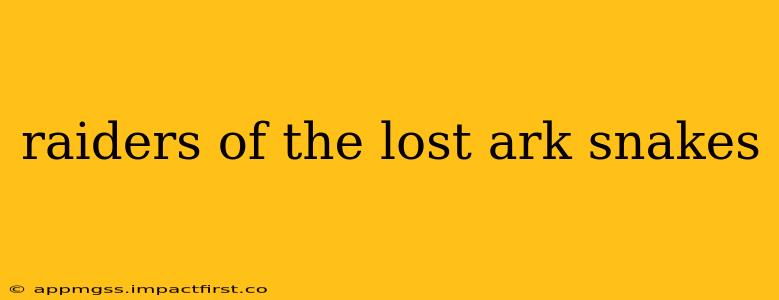The iconic snake pit scene in Raiders of the Lost Ark remains one of cinema's most memorable and terrifying sequences. Beyond the visceral thrill, it speaks volumes about Indiana Jones' character and the film's overall themes. This exploration delves into the scene's creation, its impact on viewers, and answers some frequently asked questions surrounding this chilling encounter.
What Kind of Snakes Were in the Raiders of the Lost Ark Snake Pit?
The snakes used in the snake pit scene weren't venomous, thankfully for Harrison Ford! The filmmakers utilized a variety of non-venomous snakes, mostly boa constrictors and other relatively docile species. While still undeniably creepy and numerous, their lack of venom reduced the risk to the actors and crew. The sheer number and the close proximity to Ford, however, undoubtedly contributed to the realism and intensity of the scene. The visual effect of so many snakes slithering was amplified by clever camerawork and editing techniques.
How Many Snakes Were in the Raiders of the Lost Ark Snake Pit Scene?
Pinpointing the exact number of snakes used is difficult. Reports vary, but it's safe to say hundreds of snakes were employed to create the overwhelming effect. The sheer volume of snakes was crucial to the scene's success, contributing to the feeling of inescapable dread and claustrophobia experienced by both Indiana Jones and the audience. The visual impact of a teeming mass of snakes was paramount to the scene's chilling effect.
Was Harrison Ford Afraid of Snakes in the Raiders of the Lost Ark?
Harrison Ford’s ophidiophobia (fear of snakes) is well-documented, adding another layer of intrigue to his performance in the snake pit scene. While the snakes were non-venomous, the sheer number and their close proximity undeniably tested his courage. The scene's realism owes much to Ford's genuine discomfort, which is subtly yet effectively conveyed on screen. Many accounts describe his visible discomfort during filming, making his portrayal even more compelling.
Why Was the Snake Pit Scene So Effective?
The effectiveness of the scene lies in several factors: the sheer number of snakes, the claustrophobic setting, Ford's believable reaction, and the masterful direction of Steven Spielberg. Spielberg's ability to build tension and suspense, combined with the practical effects and Ford's performance, creates a sequence that is both terrifying and unforgettable. The scene masterfully taps into primal fears, leaving a lasting impression on viewers long after the credits roll. It's a perfect example of less-is-more, the lack of dialogue adding to the suspense.
What Was the Purpose of the Snake Pit Scene in Raiders of the Lost Ark?
The snake pit serves multiple purposes within the narrative. Firstly, it's a significant obstacle for Indiana Jones, testing his courage and resourcefulness. Secondly, it highlights his vulnerability and showcases his human side amidst his heroic persona. The scene also emphasizes the dangers and challenges associated with archaeological expeditions. Finally, the sequence works on a visual level, adding a memorable and iconic element to the overall film.
What Happens After the Snake Pit Scene in Raiders of the Lost Ark?
Following his harrowing escape from the snake pit, Indiana Jones proceeds to the next stage of his quest. He must now overcome further obstacles and challenges in order to locate the Ark of the Covenant and prevent its use by the Nazis. The escape from the snake pit marks a significant turning point, solidifying his determination and resilience in the face of peril. The scene acts as a pivotal moment of triumph against the odds, moving the plot forward with urgency.
The snake pit scene in Raiders of the Lost Ark transcends its genre and becomes a powerful symbol of the film's wider themes of courage, peril, and the human spirit’s capacity for resilience in the face of overwhelming odds. It stands as a testament to the artistry of filmmaking and remains a chilling reminder of the power of visual storytelling.
